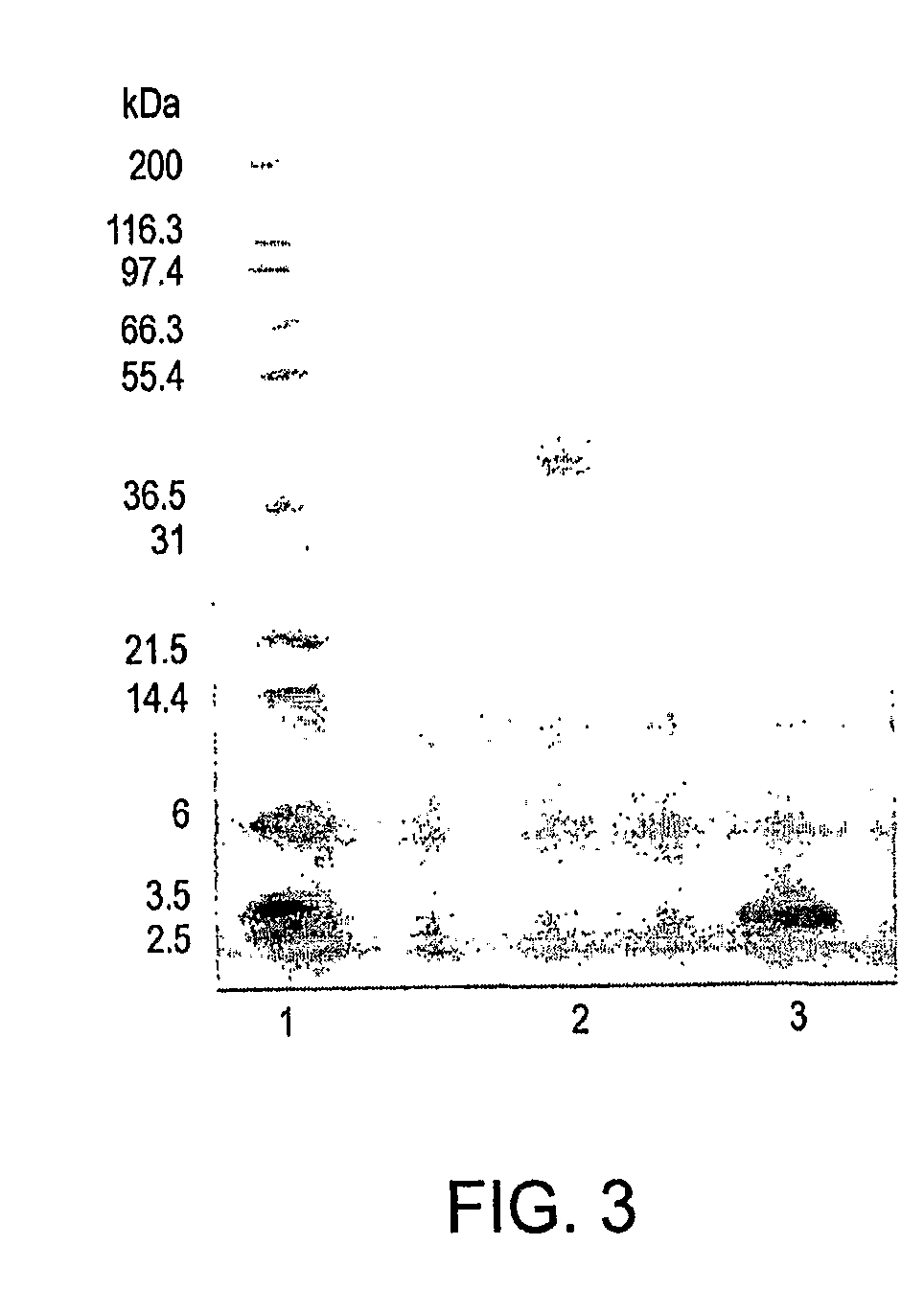Polymer conjugates of glp-1
a polymer conjugate and glp technology, applied in the field of pharmaceuticals, can solve the problems of severely hampered usefulness as a therapeutic agent, extremely short in vivo half-live, etc., and achieve the effects of lowering blood glucose level
- Summary
- Abstract
- Description
- Claims
- Application Information
AI Technical Summary
Benefits of technology
Problems solved by technology
Method used
Image
Examples
example 1
Preparation of N-{di(mPEG(20,000)oxymethylcarbonylamino)fluoren-9-ylmethoxycarbonyloxy}succinimide for Reversible PEGylation of GLP-1
[0434]
A. Preparation of 2,7-di(Boc-amino)fluorene
[0435]Under an argon atmosphere, 2,7-diaminofluorene (2.45 g, 12.5 mmol) was dissolved in 1,4-dioxane (28 mL). Deionized water (14 mL), NaOH 2M (2.2 eq, 27.5 mmol, 13.8 mL) and di-tert-butyldicarbonate (BOC2O) (2.5 eq, 31.3 mmol, 6.82 g) were added successively. The reaction was stirred vigorously for 20 hours at room temperature. Product precipitated as a brown solid. The reaction was quenched by the addition of water and acidification to pH 3 with KHSO4 1M. Product was extracted with chloroform (3×400 mL) and the combined organic layers were washed with ½ saturated brine, dried over Na2SO4 and evaporated. Product was purified by flash chromatography: silica gel 60 Å eluted with 1% methanol in chloroform. The purified yellow solid (5.1 g, ˜99%) was pure by TLC (ninhydrin stain). 1H-NMR (CDCl3): δ (ppm) ...
example 2
Preparation of N-[2,7 di(4 mPEG(10,000)aminocarbonylbutyrylamino)fluoren-9-ylmethoxycarbonyloxy]succinimide (“G2PEG2Fmoc20k-NHS”)
[0443]The synthesis of mPEG(10,000)aminocarbonylbutyrylamino)fluoren-9-ylmethoxycarbonyloxy]succinimide is represented schematically in Scheme 2 below.
A. 9-Hydroxymethyl-2,7-di(4-carboxybutyrylamino)fluorene
[0444]Under an argon atmosphere, 9-hydroxymethyl-2,7-diaminofluorene dihydrochloride (preparation described in steps A through D in Example 1) was dissolved in deionized water and adjusted to pH 8 with saturated NaHCO3. The mixture was diluted in half with brine and the precipitate was extracted with ethyl acetate. The ethyl acetate layers were dried over Na2SO4, filtered and evaporated for 9-hydroxymethyl-2,7-diaminofluorene (brown powder, 84% isolated yield).
[0445]9-Hydroxymethyl-2,7-diaminofluorene (0.38 g, 1.7 mmol) was dissolved in anhydrous tetrahydrofuran (THF) (10 mL) and glutaric anhydride (97%, 2.2 eq, 3.7 mmol, 0.435 g) was added. The reactio...
example 3
Preparation of an Exemplary GLP-1-Polymer Conjugate Having a Releasable PEG Moiety Attached to GLP-1
Preparation of G2PEG2Fmoc20k-Nter-GLP-1
[0450]An illustrative polymeric reagent, G2PEG2Fmoc20k-NHS, was covalently attached to the N-terminus of GLP-1, to provide a prodrug form of the protein wherein the PEG-moiety is releasably attached. The two-arm nature of the polymeric reagent provides increased stability to the GLP-1 moiety subsequent to administration, to thereby provide a sustained release formulation whereby GLP-1 is released from the conjugate via hydrolysis to provide the native or unmodified GLP-1 precursor. The structure of G2PEG2Fmoc20k-Nter-GLP-1 is provided below (in the structure, “GLP-1” represents a residue of GLP-1).
[0451]The polymeric reagent, G2PEG2Fmoc20K-NHS, was prepared as described above in Example 2.
[0452]A solution of 50 mg GLP-1 (nominally 1.2276×10−5 mol) (actual purity of GLP-1 was 98.5% (by HPLC), and the peptide content was 82.2%) in 25 mL of 20 mM so...
PUM
| Property | Measurement | Unit |
|---|---|---|
| molecular weight | aaaaa | aaaaa |
| molecular weight | aaaaa | aaaaa |
| retention volume | aaaaa | aaaaa |
Abstract
Description
Claims
Application Information
 Login to View More
Login to View More - R&D Engineer
- R&D Manager
- IP Professional
- Industry Leading Data Capabilities
- Powerful AI technology
- Patent DNA Extraction
Browse by: Latest US Patents, China's latest patents, Technical Efficacy Thesaurus, Application Domain, Technology Topic, Popular Technical Reports.
© 2024 PatSnap. All rights reserved.Legal|Privacy policy|Modern Slavery Act Transparency Statement|Sitemap|About US| Contact US: help@patsnap.com










